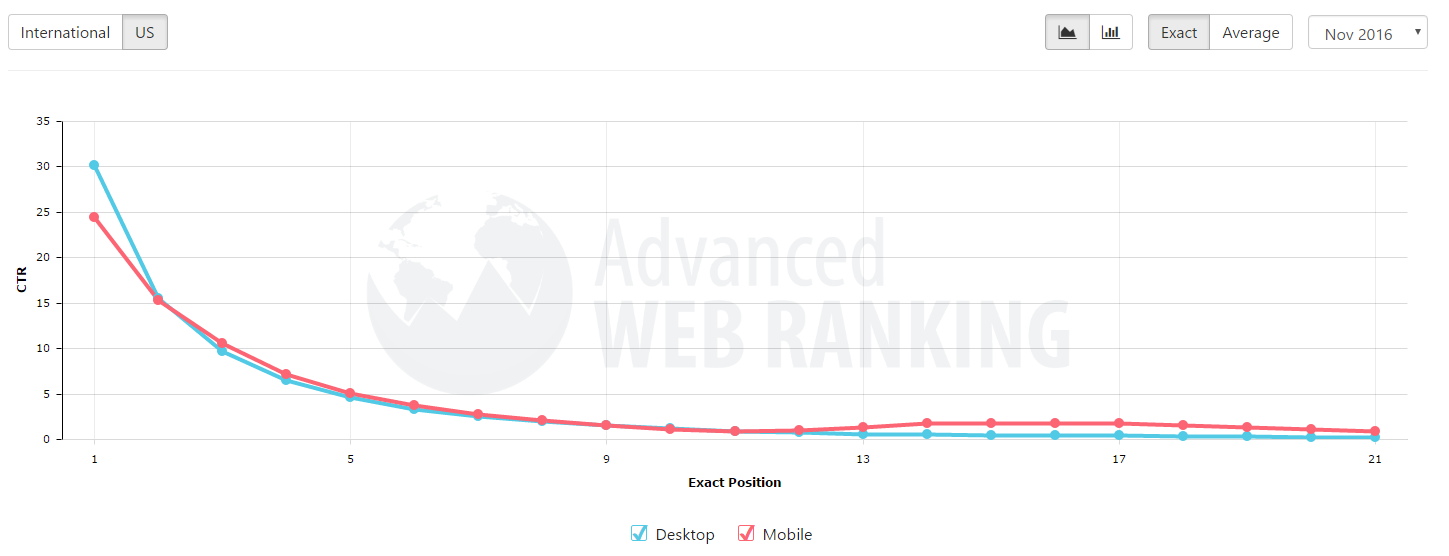As SEOs, we’re used to Google changing things up on us on the fly. Google’s most recent search algorithm update makes it clear that the way to the top of Page 1 is a total focus on your user and their intent.
SEOs for years have cited industry-standard click-through rates based on the position on a search engine results page (SERP).

Organic click-through rates for searches coming from 1,708,342 keywords for 48,280 websites.
Recently, however, Google increased the number of ads displayed at the top of a SERP. It is now up to SEOs to find a way to maintain organic traffic to our sites as we lose even more real estate on Page 1 SERPs. Here’s how CRI has done just that.
AdWords’ Manifest Destiny Approach to SERPs
Click-through rates—even for the #1 overall position in an organic search—will be lower than previously. Users may not care that they’re clicking on an ad. This is especially true for branded searches, where the user may pause only to make sure the link they’re about to click belongs to the brand they searched.
In effect, we’re dealing with a new normal—where organic as a channel is able to claim a smaller share of the overall traffic mix.
But there is hope! The expanded ad pack is visible on simple keyword searches. A branded search, or a top-of-funnel search, will likely return multiple ads at the top of the SERP. To see organic search results uncolored by the expanded reach of PPC, requires you move down funnel, to the targeted searches typical of a user who’s well into their purchasing decision.
Long-tail keywords: A New Hope
Google encourages SEOs and digital marketers to focus on meeting the information needs and expectations of their users. This focus on search intent has often been yada yada-ed by marketers to read as, “Well you obviously need to start with great content that your users want to engage with.”
Advising our clients to focus only on producing great content would be missing the point. What Google is really telling SEOs with these most recent changes to their SERPs is that a focus on long-tail keywords based on user intent is no longer an option, but a requirement. This leads to a three-step process to ensure your SEO and content strategy are working together to achieve results:
Step 1: Identify high-volume keyword ‘slugs’. Traditional keyword research will continue to play a role in effective SEO. But going forward, identifying and optimizing around high-volume keywords will occur as a byproduct of an increased emphasis on user intent, and won’t be itself an end goal.
Step 2: Understand the problem your product solves. The surest way to incorporate your high-volume keywords into relevant long-tail keyphrases is to contextualize those terms to the problems your potential customers are trying to solve. So, while your desired keyword might be, say, “charity donation”, knowing that donation efficiency is the top consideration for a significant cohort of your donors will help you identify and build out a matrix of relevant long-tail keyphrases that incorporate that keyword ‘slug’.
Step 3: Craft your keyphrase strategy to incorporate your slugs into natural language queries. Knowing your target demographics primary concerns will inform the long-tail keyphrases you target. Continuing the example from Step 2, you might optimize around, say, “best charity to donate to for [x]”, or “most efficient charity to donate to”—queries that give weight to the objections, concerns and interests your target users may hold.
A More Robust Keyphrase Strategy for the New Search Landscape
In recent months, CRI has worked with clients to develop new keyphrase strategies. It might seem like a small bit of semantic gymnastics, but the migration from keywords to keyphrases—in other words, to long-tail keywords—has allowed us to make more elegant and effective recommendations that better understand and speak to our clients’ target customers.
Implementing our updated SEO strategy has baked in a user focus to our SEO strategy that is already benefiting our clients in the form of increased search visibility and more—and more qualified—traffic.
Interested in learning more about SEO and content marketing? Read more from our blog, View from the Charles:
How Does the New Google Ad Layout Impact SEO?
Finding Trends in Your Bounce Rates
Want more information? Get more details on Charles River Interactive’s SEO service offerings or contact us today.
